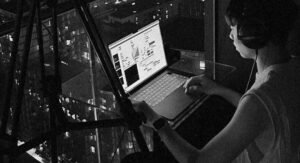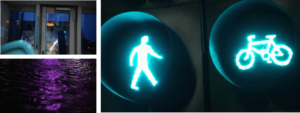This project is not just passive observation, but active exploration, turning the city into a canvas for a sonic journey. It is a testament to the beauty hidden in our everyday surroundings and an invitation to hear the world in a new way.

Process
A test at sonification was conducted as the first experiment. Images of London’s city lights, spanning the skyline to Greenwich, were captured and connected to a MIDI map to produce the sounds of these lights. However, this method was deemed too subjective. Therefore, other possible methods were explored.

The original image was processed by a frame difference method for computer recognition. The video was converted to grayscale and the flashing lights were extracted. The sound generation effects were simplified to a sine wave with different frequencies.
The sound transformation of the city lights led to an intriguing possibility – reversing this process. These audio representations could be transmuted back into visual form, influencing the original image. The idea was to create a visual echo of the lights, a sonic portrait, adding another dimension to this exploration.
This concept generation approach was unsatisfactory. It failed to express the project’s essence through visual means effectively. The sound-to-image translation did not capture the desired magic.
A deeper exploration of the sound generation of the lights was conducted. It was discovered that real-time image capture could be utilized to produce instant auditory feedback of the lights. This method enhanced the auditory representation and established a direct link between the visual and sonic aspects of the city’s light. The sound-generation system, based on camera input, allowed for the audible perception of the normally inaudible elements of the environment. It was analogous to acquiring a new sense, revealing a concealed layer of the everyday world.
Outcome
A nocturnal exploration was conducted with an unconventional ‘instrument’ to reveal the sound concealed within the lights of London at night. A short film, a visual diary that records every distinctive sound and sight encountered, is being created to capture this journey of discovery.
